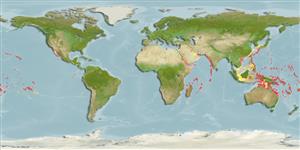Echinoidea |
Diadematoida |
Diadematidae
Environment: milieu / climate zone / depth range / distribution range
Ecology
Reef-associated; depth range 1 - 40 m (Ref. 800). Tropical
Indo-Pacific: from Indian Ocean to Tahiti and from Japan to South Pacific Islands.
Length at first maturity / Size / Weight / Age
Maturity: Lm ? range ? - ? cm Max length : 20.0 cm WD male/unsexed; (Ref. 87895)
Occurs in shallow coral and coral rubble areas at depths of 1 to 40 m (Ref. 81254), coral reefs and sandy areas (Ref. 129602). A generalist herbivore displaying nocturnal feeding behavior (Ref. 81254). Known to graze (Also Ref. 129602) on organic material and adults may also feed on live hard corals. Sometimes associated with commensal shrimp Stegopontonia commensalis (Ref. 800). Commonly found with Diadema spp. Bioeroder. Feeds on small and turf algae over hard substrates (Ref. 129602).
Life cycle and mating behavior
Maturity | Reproduction | Spawning | Eggs | Fecundity | Larvae
Members of the class Echinoidea are gonochoric. Fertilization is external. Brooding is common, eggs are held either on the peristome, around the periproct or deep into the concavities on the petaloids. Life cycle: Embryos develop into planktotrophic larvae (echinoplateus) and live for several months before they sink to the bottom using their tube feet to adhere on the ground where they metamorphose into young urchins.
Schoppe, S. 2000. (Ref. 800)
IUCN Red List Status (Ref. 130435)
CITES status (Ref. 108899)
Not Evaluated
Not Evaluated
Threat to humans
Human uses
Fisheries: commercial
| FishSource | Sea Around Us
Tools
More information
Age/SizeGrowthLength-weightLength-lengthMorphologyLarvaeAbundance
Internet sources
Estimates based on models
Preferred temperature
(Ref.
115969): 24.7 - 28.9, mean 27.5 (based on 362 cells).
Price category
Unknown.
Nutrients: Calcium = 126 [75, 177] mg/100g; Iron = 5.08 [1.67, 7.92] mg/100g; Protein = 12%; Omega3 = 0.331 [0.263, 0.400] g/100g; Selenium = 0.04 [48.48, 67.17] μg/100g; VitaminA = 0 μg/100g; Zinc = 1.97 [0.92, 3.02] mg/100g (wet weight).
